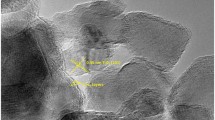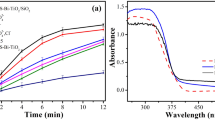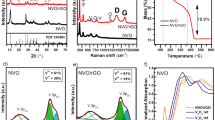Abstract
In this study, an N-ZnO/g-C3N4 (g-N-Z) Z-scheme photocatalyst was constructed using hydrothermal and high-temperature calcination. X-ray diffraction (XRD), Fourier transform infrared spectroscopy (FT-IR), X-ray photoelectron spectroscopy (XPS), and other tests were employed to characterise the catalytic material. The results showed that after N-ZnO modification, the separation efficiency of the photoinduced charge pairs and the utilisation of sunlight in the composites were improved. The kinetics experiments indicated that the degradation of atrazine (ATZ) in the g-N-Z/PDS/solar system was significantly better than that in the PDS/solar system. Under the action of the g-N-Z/PDS/solar system, the degradation rate of ATZ reached 83.88%, whereas in the PDS/solar system, it was only 31.76%. In addition, it was found that increasing the PDS concentration, g-N-Z dosage, and solution acidity effectively accelerated the removal of ATZ. The presence of HCO3−/CO32−, Cl−, and natural organic matter (NOM) inhibited the oxidation efficiency of the g-N-Z/PDS/solar system. Moreover, the presence of multiple reactive oxygen species (ROS) was confirmed using radical scavenging experiments to determine the contribution of each active component. Twelve oxidation intermediates of ATZ were obtained via liquid chromatography-tandem mass spectrometry (LC–MS/MS), and the mechanism of enhanced ATZ degradation in the g-N-Z/PDS/solar system was proposed. Actual water and cyclic photocatalytic experiments further suggest that g-N-Z has good application value in water treatment.

















Similar content being viewed by others
References
Ahn Y, Bae H, Kim H, Kim S, Kim J, Lee S, Lee J (2019) Surface-loaded metal nanoparticles for peroxymonosulfate activation: efficiency and mechanism reconnaissance. Appl Catal B 241:561–569
Chan KH, Chu W (2009) Degradation of atrazine by cobalt-mediated activation of peroxymonosulfate: different cobalt counteranions in homogenous process and cobalt oxide catalysts in photolytic heterogeneous process. Water Res 43(9):2513–2521
Chen C, Yang S, Guo Y, Sun C, Gu C, Xu B (2009) Photolytic destruction of endocrine disruptor atrazine in aqueous solution under UV irradiation: products and pathways. J Hazard Mater 172(2):675–684
Chen H, Zhang X, Jiang L, Yuan X, Liang J, Zhang J, Yu H, Chu W, Wu Z, Li H, Li Y (2021) Strategic combination of nitrogen-doped carbon quantum dots and g-C3N4: efficient photocatalytic peroxydisulfate for the degradation of tetracycline hydrochloride and mechanism insight. Sep Purif Technol 272:118947
Chen L, Hu X, Yang Y, Jiang C, Bian C, Liu C, Zhang M, Cai T (2018) Degradation of atrazine and structurally related s-triazine herbicides in soils by ferrous-activated persulfate: kinetics, mechanisms and soil-types effects. Chem Eng J 351:523–531
Cui Z, Yang H, Zhao X (2018) Enhanced photocatalytic performance of g-C3N4/Bi4Ti3O12 heterojunction nanocomposites. Mater Sci Eng, B 229:160–172
Doll TE, Frimmel FH (2005) Photocatalytic degradation of carbamazepine, clofibric acid and iomeprol with P25 and Hombikat UV100 in the presence of natural organic matter (NOM) and other organic water constituents. Water Res 39(2):403–411
Dong H, Qiang Z, Hu J, Qu J (2017) Degradation of chloramphenicol by UV/chlorine treatment: kinetics, mechanism and enhanced formation of halonitromethanes. Water Res 121:178–185
Du X, Bai X, Xu L, Yang L, Jin P (2020) Visible-light activation of persulfate by TiO2/g-C3N4 photocatalyst toward efficient degradation of micropollutants. Chem Eng J 384:123245
Faisal M, Jalalah M, Harraz FA, El-Toni AM, Khan A, Al-Assiri MS (2020) Au nanoparticles-doped g-C3N4 nanocomposites for enhanced photocatalytic performance under visible light illumination. Ceram Int 46(14):22090–22101
Guo F, Shi W, Li M, Shi Y, Wen H (2019a) 2D/2D Z-scheme heterojunction of CuInS2/g-C3N4 for enhanced visible-light-driven photocatalytic activity towards the degradation of tetracycline. Sep Purif Technol 210:608–615
Guo Y, Li C, Guo Y, Wang X, Li X (2019) Ultrasonic-assisted synthesis of mesoporous g-C3N4/Na-bentonite composites and its application for efficient photocatalytic simultaneous removal of Cr(VI) and RhB. Colloids Surf A: Physicochem Eng Aspects 578:123624
Hao R, Wang G, Tang H, Sun L, Xu C, Han D (2016) Template-free preparation of macro/mesoporous g-C3N4/TiO2 heterojunction photocatalysts with enhanced visible light photocatalytic activity. Appl Catal B 187:47–58
Huang Z, Song J, Pan L, Wang Z, Zhang X, Zou J, Mi W, Zhang X, Wang L (2015) Carbon nitride with simultaneous porous network and O-doping for efficient solar-energy-driven hydrogen evolution. Nano Energy 12:646–656
Huo P, Zhou M, Tang Y, Liu X, Ma C, Yu L, Yan Y (2016) Incorporation of N-ZnO/CdS/Graphene oxide composite photocatalyst for enhanced photocatalytic activity under visible light. J Alloy Compd 670:198–209
Jang E, Kim DW, Hong SH, Park YM, Park TJ (2019) Visible light-driven g-C3N4@ZnO heterojunction photocatalyst synthesized via atomic layer deposition with a specially designed rotary reactor. Appl Surf Sci 487:206–210
Ji Y, Dong C, Kong D, Lu J, Zhou Q (2015) Heat-activated persulfate oxidation of atrazine: implications for remediation of groundwater contaminated by herbicides. Chem Eng J 263:45–54
Jiang C, Yang Y, Zhang L, Lu D, Lu L, Yang X, Cai T (2020a) Degradation of Atrazine, Simazine and Ametryn in an arable soil using thermal-activated persulfate oxidation process: optimization, kinetics, and degradation pathway. J Hazard Mater 400:123201
Jiang J, Wang X, Zhang C, Li T, Lin Y, Xie T, Dong S (2020b) Porous 0D/3D NiCo2O4/g-C3N4 accelerate emerging pollutant degradation in PMS/vis system: degradation mechanism, pathway and toxicity assessment. Chem Eng J 397:125356
Jin C, Kang J, Li Z, Wang M, Wu Z, Xie Y (2020a) Enhanced visible light photocatalytic degradation of tetracycline by MoS2/Ag/g-C3N4 Z-scheme composites with peroxymonosulfate. Appl Surf Sci 514:146076
Jin C, Wang M, Li Z, Kang J, Zhao Y, Han J, Wu Z (2020b) Two dimensional Co3O4/g-C3N4 Z-scheme heterojunction: mechanism insight into enhanced peroxymonosulfate-mediated visible light photocatalytic performance. Chem Eng J 398:125569
Kong J, Zhai H, Zhang W, Wang S, Zhao X, Li M, Li H, Li A, Wu D (2017) Visible light-driven photocatalytic performance of N-doped ZnO/g-C3N4 nanocomposites. Nanoscale Res Lett 12(1):526
Lai L, Zhou H, Zhang H, Ao Z, Pan Z, Chen Q, Xiong Z, Yao G, Lai B (2020) Activation of peroxydisulfate by natural titanomagnetite for atrazine removal via free radicals and high-valent iron-oxo species. Chem Eng J 387:124165
Li N, Tian Y, Zhao J, Zhang J, Zuo W, Kong L, Cui H (2018a) Z-scheme 2D/3D g-C3N4@ZnO with enhanced photocatalytic activity for cephalexin oxidation under solar light. Chem Eng J 352:412–422
Li X, Xiong J, Gao X, Huang J, Feng Z, Chen Z, Zhu Y (2019) Recent advances in 3D g-C3N4 composite photocatalysts for photocatalytic water splitting, degradation of pollutants and CO2 reduction. J Alloy Compd 802:196–209
Li Y, Ho W, Lv K, Zhu B, Lee SC (2018b) Carbon vacancy-induced enhancement of the visible light-driven photocatalytic oxidation of NO over g-C3N4 nanosheets. Appl Surf Sci 430:380–389
Liu B, Guo W, Wang H, Si Q, Zhao Q, Luo H, Ren N (2020a) Activation of peroxymonosulfate by cobalt-impregnated biochar for atrazine degradation: the pivotal roles of persistent free radicals and ecotoxicity assessment. J Hazard Mater 398:122768
Liu H, Zhang H, Chen M, Zhang C, Du C, Peng J, Jiang K (2020b) Peroxymonosulfate-assisted photocatalysis with g-C3N4/BiOCOOH nanocomposites for the synergistic removal of organic pollutants. J Water Process Eng 38:101580
Liu L, Ding L, Liu Y, An W, Lin S, Liang Y, Cui W (2017) A stable Ag3PO4@PANI core@shell hybrid: enrichment photocatalytic degradation with π-π conjugation. Appl Catal B 201:92–104
Liu Y, Liu H, Zhou H, Li T, Zhang L (2019) A Z-scheme mechanism of N-ZnO/g-C3N4 for enhanced H2 evolution and photocatalytic degradation. Appl Surf Sci 466:133–140
Liu Y, Zheng Y, Zhang W, Peng Z, Xie H, Wang Y, Guo X, Zhang M, Li R, Huang Y (2021) Template-free preparation of non-metal (B, P, S) doped g-C3N4 tubes with enhanced photocatalytic H2O2 generation. J Mater Sci Technol 95:127–135
Lou X, Fang C, Geng Z, Jin Y, Xiao D, Wang Z, Liu J, Guo Y (2017) Significantly enhanced base activation of peroxymonosulfate by polyphosphates: kinetics and mechanism. Chemosphere 173:529–534
Luo C, Gao J, Wu D, Jiang J, Liu Y, Zhou W, Ma J (2019) Oxidation of 2,4-bromophenol by UV/PDS and formation of bromate and brominated products: a comparison to UV/H2O2. Chem Eng J 358:1342–1350
Lv Y, Li Z, Zhou X, Cheng S, Zheng L (2020) Stabilization of source-separated urine by heat-activated peroxydisulfate. Sci Total Environ 749:142213
Nasseri S, Mahvi AH, Seyedsalehi M, Yaghmaeian K, Nabizadeh R, Alimohammadi M, Safari GH (2017) Degradation kinetics of tetracycline in aqueous solutions using peroxydisulfate activated by ultrasound irradiation: effect of radical scavenger and water matrix. J Mol Liq 241:704–714
Nie C, Dai Z, Meng H, Duan X, Qin Y, Zhou Y, Ao Z, Wang S, An T (2019) Peroxydisulfate activation by positively polarized carbocatalyst for enhanced removal of aqueous organic pollutants. Water Res 166:115043
Sánchez-Cid P, Jaramillo-Páez C, Navío JA, Martín-Gómez AN, Hidalgo MC (2019) Coupling of Ag2CO3 to an optimized ZnO photocatalyst: advantages vs. disadvantages. J Photochem Photobiol, A 369:119–132
Shao H, Zhao X, Wang Y, Mao R, Wang Y, Qiao M, Zhao S, Zhu Y (2017) Synergetic activation of peroxymonosulfate by Co3O4 modified g-C3N4 for enhanced degradation of diclofenac sodium under visible light irradiation. Appl Catal B 218:810–818
Shi Y, Li J, Wan D, Huang J, Liu Y (2020) Peroxymonosulfate-enhanced photocatalysis by carbonyl-modified g-C3N4 for effective degradation of the tetracycline hydrochloride. Sci Total Environ 749:142313
Song H, Yan L, Wang Y, Jiang J, Ma J, Li C, Wang G, Gu J, Liu P (2020a) Electrochemically activated PMS and PDS: radical oxidation versus nonradical oxidation. Chem Eng J 391:123560
Song Y, Huang L, Zhang X, Zhang H, Wang L, Zhang H, Liu Y (2020b) Synergistic effect of persulfate and g-C3N4 under simulated solar light irradiation: implication for the degradation of sulfamethoxazole. J Hazard Mater 393:122379
Song Y, Qi J, Tian J, Gao S, Cui F (2018) Construction of Ag/g-C3N4 photocatalysts with visible-light photocatalytic activity for sulfamethoxazole degradation. Chem Eng J 341:547–555
Sun J, Bu L, Chen S, Lu X, Wu Y, Shi Z, Zhou S (2019) Oxidation of Microcystic-LR via the solar/chlorine process: radical mechanism, pathways and toxicity assessment. Ecotox Environ Safe 183:109509
Tokumura M, Sugawara A, Raknuzzaman M, Habibullah-Al-Mamun M, Masunaga S (2016) Comprehensive study on effects of water matrices on removal of pharmaceuticals by three different kinds of advanced oxidation processes. Chemosphere 159:317–325
Wang C, Xue Y, Wang P, Ao Y (2018) Effects of water environmental factors on the photocatalytic degradation of sulfamethoxazole by AgI/UiO-66 composite under visible light irradiation. J Alloycompd 748:314–322
Wang J, Cui C, Li Y, Liu L, Zhang Y, Shi W (2017) Porous Mn doped g-C3N4 photocatalysts for enhanced synergetic degradation under visible-light illumination. J Hazard Mater 339:43–53
Wang L, Guo X, Chen Y, Ai S, Ding H (2019) Cobalt-doped g-C3N4 as a heterogeneous catalyst for photo-assisted activation of peroxymonosulfate for the degradation of organic contaminants. Appl Surf Sci 467–468:954–962
Wang S, Li D, Sun C, Yang S, Guan Y, He H (2014) Synthesis and characterization of g-C3N4/Ag3VO4 composites with significantly enhanced visible-light photocatalytic activity for triphenylmethane dye degradation. Appl Catal B 144:885–892
Wang S, Luo C, Tan F, Cheng X, Ma Q, Wu D, Li P, Zhang F, Ma J (2021) Degradation of Congo red by UV photolysis of nitrate: kinetics and degradation mechanism. Sep Purif Technol 262:118276
Wu Z, Guo K, Fang J, Yang X, Xiao H, Hou S, Kong X, Shang C, Yang X, Meng F, Chen L (2017) Factors affecting the roles of reactive species in the degradation of micropollutants by the UV/chlorine process. Water Res 126:351–360
Xie M, Tang J, Kong L, Lu W, Natarajan V, Zhu F, Zhan J (2019) Cobalt doped g-C3N4 activation of peroxymonosulfate for monochlorophenols degradation. Chem Eng J 360:1213–1222
Xu J, Long K, Wang Y, Xue B, Li Y (2015) Fast and facile preparation of metal-doped g-C3N4 composites for catalytic synthesis of dimethyl carbonate. Appl Catal A 496:1–8
Yan SC, Li ZS, Zou ZG (2009) Photodegradation performance of g-C3N4 fabricated by directly heating melamine. Langmuir 25(17):10397–10401
Yin R, Zhong Z, Ling L, Shang C (2018) The fate of dichloroacetonitrile in UV/Cl2 and UV/H2O2 processes: implications on potable water reuse. Environ Sci: Water Res Technol 4(9):1295–1302
Zhang J, Zhao X, Wang Y, Gong Y, Cao D, Qiao M (2018) Peroxymonosulfate-enhanced visible light photocatalytic degradation of bisphenol A by perylene imide-modified g-C3N4. Appl Catal B 237:976–985
Zhang R, Han Q, Li Y, Zhang T, Liu Y, Zeng K, Zhao C (2020) Solvothermal synthesis of a peony flower-like dual Z-scheme PANI/BiOBr/ZnFe2O4 photocatalyst with excellent photocatalytic redox activity for organic pollutant under visible-light. Sep Purif Technol 234:116098
Zhang R, Wan Y, Peng J, Yao G, Zhang Y, Lai B (2019) Efficient degradation of atrazine by LaCoO3/Al2O3 catalyzed peroxymonosulfate: performance, degradation intermediates and mechanism. Chem Eng J 372:796–808
Zhao L, Yang D, Ma L, Feng X, Ding H (2021) An efficient heterogeneous catalyst of FeCo2O4/g-C3N4 composite for catalytic peroxymonosulfate oxidation of organic pollutants under visible light. Colloids Surf A 610:125725
Zhao Z, Zhang W, Liu W, Li Y, Ye J, Liang J, Tong M (2020) Single-atom silver induced amorphization of hollow tubular g-C3N4 for enhanced visible light-driven photocatalytic degradation of naproxen. Sci Total Environ 742:140642
Zhou L, Wang L, Lei J, Liu Y, Zhang J (2017) Fabrication of TiO2/Co-g-C3N4 heterojunction catalyst and its photocatalytic performance. Catal Commun 89:125–128
Zhu Y, Wang T, Xu T, Li Y, Wang C (2019) Size effect of Pt co-catalyst on photocatalytic efficiency of g-C3N4 for hydrogen evolution. Appl Surf Sci 464:36–42
Zuo Z, Cai Z, Katsumura Y, Chitose N, Muroya Y (1999) Reinvestigation of the acid–base equilibrium of the (bi)carbonate radical and pH dependence of its reactivity with inorganic reactants. Radiat Phys Chem 55(1):15–23
Funding
This study is financially supported by the Shandong Top Talent Special Foundation, the Introduction and Cultivation Plan for Young Innovative Talents of Colleges and Universities by the Education Department of Shandong Province, the National Natural Science Foundation of China (Grant Nos. 51908335 and 52270200), China Postdoctoral Science Foundation (Grant Nos. 2020M672085), the post-doctoral innovation project of Shandong Province (Grant Nos. 317202002023). This work was supported by the Central Government Guides of the Local Science and Technology Development Special Project (Grant Nos. 2020ZY0068).
Author information
Authors and Affiliations
Corresponding author
Additional information
Responsible Editor: George Z. Kyzas
Publisher's note
Springer Nature remains neutral with regard to jurisdictional claims in published maps and institutional affiliations.
Supplementary Information
Below is the link to the electronic supplementary material.
Rights and permissions
Springer Nature or its licensor (e.g. a society or other partner) holds exclusive rights to this article under a publishing agreement with the author(s) or other rightsholder(s); author self-archiving of the accepted manuscript version of this article is solely governed by the terms of such publishing agreement and applicable law.
About this article
Cite this article
Chen, Y., Luo, C., Tan, F. et al. Synergistic mechanism and degradation kinetics for atrazine elimination by integrated N-ZnO/g-C3N4/solar light/oxidant. Environ Sci Pollut Res 30, 26032–26049 (2023). https://doi.org/10.1007/s11356-022-23931-8
Received:
Accepted:
Published:
Issue Date:
DOI: https://doi.org/10.1007/s11356-022-23931-8




